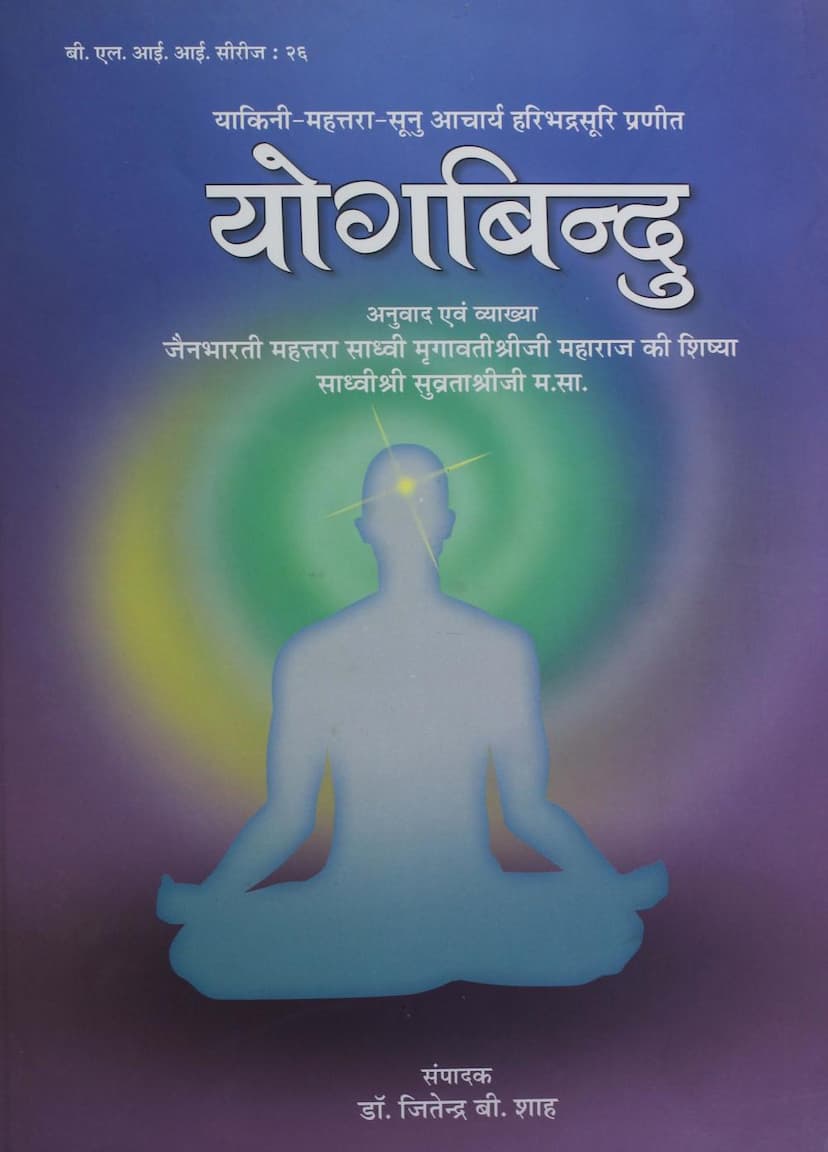Prachin Stavanavli 23 Parshwanath
Added to library: September 2, 2025

Summary
Here's a comprehensive summary of the provided Jain text, "योगबिन्दु" (Yogabindu) by Acharya Haribhadrasuri, with its Hindi translation and commentary by Sadhvi Suvrata Shreeji:
Title: Yogabindu (योगबिन्दु) Author: Acharya Haribhadrasuri (आचार्य हरिभद्रसूरि) Translation & Commentary: Sadhvi Suvrata Shreeji (साध्वी सुव्रताश्रीजी म.सा.) Editor: Dr. Jitendra B. Shah (डॉ. जितेन्द्र बी. शाह) Publisher: B. L. Institute of Indology, Delhi Series: B. L. I. I. Series: 26
Core Theme:
This book is a profound treatise on Jain Yoga, authored by the renowned scholar-monk Acharya Haribhadrasuri, who lived in the 8th century CE. Acharya Haribhadrasuri is celebrated for his ability to harmonize the principles of various Indian philosophical schools with Jainism, demonstrating the non-contradictory nature of anekantavada (the principle of manifold aspects). The Yogabindu is a prime example of this syncretic approach. The central theme is the exposition of Yoga as a path to Moksha (liberation), defining it as the union of the soul with its pure, inherent state.
Key Contributions and Features:
-
Syncretism and Harmony: Acharya Haribhadrasuri's genius lies in his ability to integrate diverse philosophical and yogic traditions within the Jain framework. He acknowledges the validity of different paths to liberation, stating that while the methods may vary, the ultimate goal of Moksha is the same for all. This demonstrates a profound understanding and practice of anekantavada.
-
Defining Yoga: The text critically examines various definitions of Yoga. While Patanjali defines Yoga as the cessation of mental modifications (Yogaḥ citta-vr̥tti-nirodhaḥ), Acharya Haribhadrasuri emphasizes Yoga as a means of union (yoga from yuj). Specifically, he defines Yoga as that which connects the soul to Moksha (Mokṣeṇa yojanād yogaḥ). This expands the concept of Yoga beyond mere yogic postures or mind control to encompass all righteous actions and spiritual practices that lead to liberation.
-
The Five Limbs of Yoga: Rejecting the prevalent Ashtanga Yoga system, Acharya Haribhadrasuri presents a unique Jain five-limbed path to Yoga:
- Adhyatma (अध्यात्म): Contemplation of the true nature of the soul, distinguishing between the soul (pure consciousness) and the non-soul (karma, body, senses). It involves understanding the three states of the soul: bahirātmā (outward-focused), antarātmā (inward-focused), and paramātmā (liberated soul).
- Bhāvanā (भावना): Cultivating specific meditative contemplations (like impermanence, non-attachment, solitude, purity, etc.) to purify the mind and detach from worldly desires. Twelve such bhāvanās are mentioned.
- Dhyāna (ध्यान): Focused meditation, particularly on the nature of the soul and the liberated beings (vitarāga). The text distinguishes between beneficial (śukla and dharma) and harmful (ārta and raudra) forms of meditation.
- Samatā (समता): Cultivating equanimity and balance of mind in the face of dualities like pleasure and pain, praise and criticism, honor and dishonor.
- Vr̥ttisaṅkṣaya (वृत्तिसंक्षय): The ultimate cessation of all mental and karmic modifications, leading to the soul's inherent pure state – Moksha.
-
Reconciling Philosophy: The Yogabindu meticulously analyzes and often harmonizes concepts from other schools like Vedanta, Sankhya, and Buddhism with Jain philosophy. It demonstrates how the core principles of these traditions, when understood through the lens of Jain metaphysics (anekantavada), do not necessarily contradict Jain teachings on liberation.
-
Importance of Conduct and Ethics: While acknowledging the role of internal states, the text places significant emphasis on ethical conduct, righteousness, and the practice of virtues as integral to the yogic path. The concept of purva-seva (preliminary practices) includes devotion to Gurus, virtuous individuals, and adherence to scriptures.
-
Critique of Extremes: Acharya Haribhadrasuri critiques extreme philosophical viewpoints, such as eternalism (attributing an unchanging, static nature to the soul) and nihilism (denying the soul's existence or continuity), advocating for a balanced perspective that acknowledges both permanence and change in the soul's journey.
-
Accessibility of the Translation: The Hindi translation and commentary by Sadhvi Suvrata Shreeji are praised for their simplicity and clarity. She skillfully uses quotes and references from Jain and other spiritual texts to explain complex concepts, making the profound subject matter of Yoga and philosophy accessible to a wider audience.
-
Editorial Contribution: Dr. Jitendra B. Shah's scholarly editing and introductory essay are highlighted for their role in presenting the vast knowledge within Yogabindu in a concise, well-organized, and understandable manner, serving as an excellent gateway to Jain yogic philosophy.
Overall Significance:
Yogabindu stands as a testament to Acharya Haribhadrasuri's scholarly prowess and his inclusive, harmonizing approach to spirituality. The text offers a comprehensive framework for understanding Yoga from a Jain perspective, emphasizing the ultimate goal of liberation through self-realization and the purification of the soul. The translation and commentary by Sadhvi Suvrata Shreeji make this ancient wisdom accessible to modern practitioners, offering guidance on the path to spiritual advancement. The book is considered a vital resource for anyone seeking to understand Jain yoga and its philosophical underpinnings.